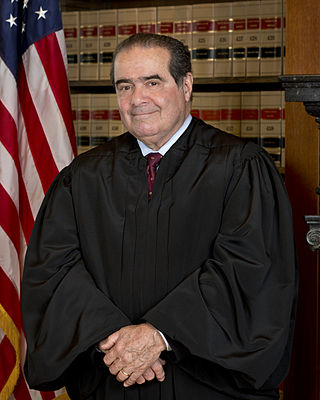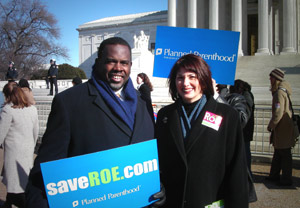
Antonin Gregory Scalia was an American jurist who served as an associate justice of the Supreme Court of the United States from 1986 until his death in 2016. He was described as the intellectual anchor for the originalist and textualist position in the U.S. Supreme Court's conservative wing. For catalyzing an originalist and textualist movement in American law, he has been described as one of the most influential jurists of the twentieth century, and one of the most important justices in the history of the Supreme Court. Scalia was posthumously awarded the Presidential Medal of Freedom in 2018, and the Antonin Scalia Law School at George Mason University was named in his honor.

The United States abortion-rights movement is a sociopolitical movement in the United States supporting the view that a woman should have the legal right to an elective abortion, meaning the right to terminate her pregnancy, and is part of a broader global abortion-rights movement. The movement consists of a variety of organizations, with no single centralized decision-making body.

John Glover Roberts Jr. is an American jurist who has served as the 17th chief justice of the United States since 2005. He has been described as having a moderate conservative judicial philosophy, though he is primarily an institutionalist. For his willingness to work with the Supreme Court's liberal bloc, Roberts has been regarded as a swing vote on the U.S. Supreme Court.
Scheidler v. National Organization for Women, 547 U.S. 9 (2006), was a lengthy and high-profile U.S. legal case interpreting and applying the federal Racketeer Influenced and Corrupt Organizations Act (RICO): a law originally drafted to combat the mafia and organized crime, the Hobbs Act: an anti-extortion law prohibiting interference with commerce by violence or threat of violence, and the Travel Act: a law prohibiting interstate travel in support of racketeering.

The Freedom of Access to Clinic Entrances Act is a United States law that was signed by President Bill Clinton in May 1994, which prohibits the following three things: (1) the use of physical force, threat of physical force, or physical obstruction to intentionally injure, intimidate, interfere with or attempt to injure, intimidate or interfere with any person who is obtaining an abortion, (2) the use of physical force, threat of physical force, or physical obstruction to intentionally injure, intimidate, interfere with or attempt to injure, intimidate or interfere with any person who is exercising or trying to exercise their First Amendment right of religious freedom at a place of religious worship, (3) the intentional damage or destruction of a reproductive health care facility or a place of worship.
Governments sometimes take measures designed to afford legal protection of access to abortion. Such legislation often seeks to guard facilities which provide induced abortion against obstruction, vandalism, picketing, and other actions, or to protect patients and employees of such facilities from threats and harassment.
The timeline of women's legal rights (other than voting) represents formal changes and reforms regarding women's rights. The changes include actual law reforms, as well as other formal changes (e.g. reforms through new interpretations of laws by precedents). The right to vote is exempted from the timeline: for that right, see Timeline of women's suffrage. The timeline excludes ideological changes and events within feminism and antifeminism; for that, see Timeline of feminism.

In re Article 26 and the Regulation of Information Bill 1995 [1995] 1 IR 1 was a decision of the Supreme Court of Ireland after a referral by President Mary Robinson under Article 26 of the Constitution of Ireland. This is a procedure whereby the constitutionality of a bill is considered by the Supreme Court before it is signed into law, similar to the concept of a facial challenge in the United States. If the Court finds that it is constitutional, it may not later be challenged after its enactment.
This is a timeline of reproductive rights legislation, a chronological list of laws and legal decisions affecting human reproductive rights. Reproductive rights are a sub-set of human rights pertaining to issues of reproduction and reproductive health. These rights may include some or all of the following: the right to legal or safe abortion, the right to birth control, the right to access quality reproductive healthcare, and the right to education and access in order to make reproductive choices free from coercion, discrimination, and violence. Reproductive rights may also include the right to receive education about contraception and sexually transmitted infections, and freedom from coerced sterilization, abortion, and contraception, and protection from practices such as female genital mutilation (FGM).
Hill v. Colorado, 530 U.S. 703 (2000), was a United States Supreme Court decision. The Court ruled 6–3 that the First Amendment right to free speech was not violated by a Colorado law limiting protest, education, distribution of literature, or counseling within eight feet of a person entering a healthcare facility.
The Family Planning Services and Population Research Act of 1970 is the only federal grant program dedicated to providing individuals with comprehensive family planning and related preventive health services. It was signed into law under President Richard Nixon on December 24, 1970.
Legal Services Corp. v. Velazquez, 531 U.S. 533 (2001), is a decision of the Supreme Court of the United States concerning the constitutionality of funding restrictions imposed by the United States Congress. At issue were restrictions on the Legal Services Corporation (LSC), a private, nonprofit corporation established by Congress. The restrictions prohibited LSC attorneys from representing clients attempting to amend existing welfare law. The case was brought by Carmen Velazquez, whose LSC-funded attorneys sought to challenge existing welfare provisions since they believed that it was the only way to get Velazquez financial relief.
Madsen v. Women's Health Center, Inc., 512 U.S. 753 (1994), is a United States Supreme Court case where Petitioners challenged the constitutionality of an injunction entered by a Florida state court which prohibits antiabortion protesters from demonstrating in certain places, and in various ways outside of a health clinic that performs abortions.
Abortion is the termination of human pregnancy, often performed in the first 28 weeks of pregnancy. In 1973, the United States Supreme Court in Roe v. Wade recognized a constitutional right to obtain an abortion without excessive government restriction, and in 1992 the Court in Planned Parenthood v. Casey invalidated restrictions that create an undue burden on people seeking abortions. Since then, there has continued to be an abortion debate in the United States, and some states have passed laws in the form of regulation of abortions but which have the purpose or effect of restricting its provision. The proponents of such laws argue they do not create an undue burden. Some state laws that impact the availability of abortions have been upheld by courts. In 2022, Roe and Casey were overturned by the Supreme Court in Dobbs v. Jackson Women's Health Organization, meaning that states may now regulate abortion in ways that were not previously permitted.
While some protests of the anti-abortion movement use violent methods, most protesters use a range of physically non-violent tactics, which may nonetheless include emotionally violent acts, such as intimidation or harassment.
McCullen v. Coakley, 573 U.S. 464 (2014), is a United States Supreme Court case involving a First Amendment challenge to the validity of a Massachusetts law establishing 35-foot (11 m) fixed buffer zones around facilities where abortions were performed.
The following timeline represents formal legal changes and reforms regarding women's rights in the United States except voting rights. It includes actual law reforms as well as other formal changes, such as reforms through new interpretations of laws by precedents.
National Institute of Family and Life Advocates v. Becerra, 585 U.S. 755 (2018), was a case before the Supreme Court of the United States addressing the constitutionality of California's FACT Act, which mandated that crisis pregnancy centers provide certain disclosures about state services. The law required that licensed centers post visible notices that other options for pregnancy, including abortion, are available from state-sponsored clinics. It also mandated that unlicensed centers post notice of their unlicensed status. The centers, typically run by Christian non-profit groups, challenged the act on the basis that it violated their free speech. After prior reviews in lower courts, the case was brought to the Supreme Court, asking "Whether the disclosures required by the California Reproductive FACT Act violate the protections set forth in the free speech clause of the First Amendment, applicable to the states through the Fourteenth Amendment."
Abortion in Maryland is legal at all stages of pregnancy. The first laws regulating abortion in the state were passed in 1867 and 1868, banning abortion except by a physician to "secure the safety of the mother." Abortion providers continued to operate both within and outside of the law. Legal enforcement became more strict from the 1940s through 60s, with numerous police raids on abortion providers. In 1968, Maryland passed a liberalized abortion law that clarified the wording of the previous law, allowing abortion in hospital settings in cases of rape, severe fetal deformity, or when life and health were endangered.
Box v. Planned Parenthood of Indiana and Kentucky, Inc., No. 18-483, 587 U.S. ___, 139 S.Ct. 1780 (2019), was a United States Supreme Court case dealing with the constitutionality of a 2016 anti-abortion law passed in the state of Indiana. Indiana's law sought to ban abortions performed solely on the basis of the fetus' gender, race, ethnicity, or disabilities. Lower courts had blocked enforcement of the law for violating a woman's right to abortion under privacy concerns within the Fourteenth Amendment, as previously found in the landmark cases Roe v. Wade and Planned Parenthood v. Casey. The lower courts also blocked enforcement of another portion of the law that required the disposal of aborted fetuses through burial or cremation. The per curiam decision by the Supreme Court overturned the injunction on the fetal disposal portion of the law, but otherwise did not challenge or confirm the lower courts' ruling on the non-discrimination clauses, leaving these in place.





